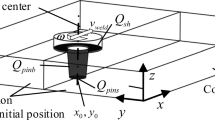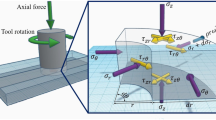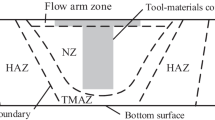Abstract
The residual stress is non-uniform in the thickness direction for thick plates jointed by friction stir welding (FSW). An analytical method by using the material flow in the welding process is proposed to solve the non-uniform residual stress of thick plates. The streamline model for the material flow is established in terms of the relationship between stream function and velocity fields in the weld. The cumulative plastic strain is computed by integrating the strain rate along each streamline. The residual stress field is obtained based on characteristic strain theories. Experiments of FSW are conducted for thick plates of aluminum alloy 2024-T3. The residual stresses in the welded region are measured by both X-ray diffraction and the contour method. The relative error of the predicted residual stress in the top surface of the weld is 4.8%. The accuracy of the analytical model can be verified. The analytical and experimental results show that the distribution of residual stress is asymmetric with a conventional “M” shape, and the distance of the two peak stresses is 40.63 mm in the top surface of the weldment. The flow mechanism of material and residual stress in different regions of thick plates by FSW are revealed. The proposed model may be used for the prediction and analysis of the non-uniform distribution of residual stress in thick plates jointed by FSW.















Similar content being viewed by others
Abbreviations
- \({\xi }_{\mathrm{tp}}\) :
-
Dimensionless variable, \({\xi }_{\mathrm{tp}}=z/H\)
- H :
-
Thickness of workpiece
- \({v}_{\mathrm{weld}}\) :
-
Welding speed
- \({r}_{\mathrm{pin}}\) :
-
Radius of pin
- r :
-
Distance between reference point and welding center
- \(\omega\) :
-
Angular speed of rotating pin
- Re:
-
Reynolds number
- \({v}_{x,F}\), \({v}_{y,F}\), \({v}_{z,F}\) :
-
Velocity components in flow arm zone
- \({v}_{x,N}\), \({v}_{y,N}\), \({v}_{z,N}\) :
-
Velocity components in nugget zone
- \(\psi\) :
-
Stream function
- \(\Omega\) :
-
Vorticity function
- \(\theta\) :
-
Angel from reference point to welding center
- \({\mathrm{v}}\) :
-
Vector of material flow velocity in the weld
- A :
-
Vector potential function
- \({\chi }_{c}\) , \({\psi }_{c}\) , \({\phi }_{c}\) :
-
Clebsch scalar potentials
- F, \(\dot{{\varvec{F}}}\) :
-
Deformation gradient tensor and the derivative to time
- u :
-
Displacement tensor
- E :
-
Green strain tensor
- L :
-
Velocity gradient tensor
- D :
-
Symmetrical deformational rate
- W :
-
Asymmetrical rotational rate
- \(\dot{{\varvec{E}}}\) :
-
Strain rate tensor
- u, v, w, \(\dot{u}\), \(\dot{v}\), \(\dot{w}\) :
-
Displacement components and the derivative to time
- \({{\varvec{\varepsilon}}}_{ij}\) :
-
Total strain tensor
- \({{\varvec{\varepsilon}}}_{ij}^{*}\) :
-
Characteristic strain tensor
- \(\nabla\) :
-
Gradient operator
- \(\Delta {u}_{s}\) :
-
Displacement increment in the streamline
- \({v}_{\mathrm{ave}}\) :
-
Average speed of material flow
- \({e}_{ij}\) :
-
Elastic strain tensor
- \({\sigma }_{ij}\) :
-
Stress tensor
- \({C}_{ijkl}\) :
-
Elastic modulus tensor
- \({f}_{i}\) :
-
Body force
- \({n}_{j}\) :
-
Unit normal vector to the boundary
- \({e}_{ijk}\) :
-
Permutation symbol
- \({G}_{ij}\) :
-
Green’s function
- \({\mathrm{N}}(\xi )\), \({\mathrm{D}}_{g}(\xi )\) :
-
Material parameters depend on the structural stiffness
- \(\xi\) :
-
Instantaneous coordinate
- \(\lambda\), \(\mu\) :
-
Lame constants
- v :
-
Poisson ratio
References
Withers P, Bhadeshia H (2001) Residual stress. Part 2-nature and origins. Mater Sci Tech-lond 17(4):366–375
James M, Hughes D, Chen Z, Lombard H, Hattingh D, Asquith D, Yates J, Webster P (2007) Residual stresses and fatigue performance. Eng Fail Anal 14(2):384–395
Altenkirch J, Steuwer A, Peel M, Richards D, Withers P (2008) The effect of tensioning and sectioning on residual stresses in aluminium AA7749 friction stir welds. Mater Sci Eng A 488(1–2):16–24
Abbasi M, Bagheri B, Sharifi F (2021) Simulation and experimental study of dynamic recrystallization process during friction stir vibration welding of magnesium alloys. T Nonferr Metal Soc 31(9):2626–2650
Bagheri B, Shamsipur A, Abdollahzadeh A, Mirsalehi S (2023) Investigation of SiC nanoparticle size and distribution effects on microstructure and mechanical properties of Al/SiC/Cu composite during the FSSW process: experimental and simulation. Met Mater Int 29:1095–1112
Salih O, Ou H, Sun W (2023) Heat generation, plastic deformation and residual stresses in friction stir welding of aluminum alloy. Int J Mech Sci 238:107827
Kandil F, Lord J, Fry A, Grant P (2001) A review of residual stress measurement methods—a guide to technique selection. National Physical Laboratory, Teddington, UK, Report 1–42
Prime M (1999) Residual stress measurement by successive extension of a slot: the crack compliance method. Appl Mech Rev 52(2):75–96
Ghidini T, Donne C (2010) Fatigue crack propagation assessment based on residual stresses obtained through cut-compliance technique. Fatigue Fract Eng M 30(3):214–222
Fratini L, Pasta S, Reynolds A (2009) Fatigue crack growth in 2024–t351 friction stir welded joints: longitudinal residual stress and microstructural effects. Int J Fatigue 31:495–500
Liu C, Yi X (2013) Residual stress measurement on AA6061-T6 aluminum alloy friction stir butt welds using contour method. Mater Design 463(1):66–371
Sun T, Tremsin A, Roy M, Hofmann M, Prangnell P, Withers P (2018) Investigation of residual stress distribution and texture evolution in AA7050 stationary shoulder friction stir welded joints. Mater Sci Eng A 712(3):531–538
Abbasi M, Abdollahzadeh A, Bagheri B, Moghaddam A, Sharifi F, Dadaei M (2021) Study on the effect of the welding environment on the dynamic recrystallization phenomenon and residual stresses during the friction stir welding process of aluminum alloy. Proc IMechE Part L: J Mater: Des Appl 235(8):1809-1826
Zapata J, Toro M, López D (2016) Residual stresses in friction stir dissimilar welding of aluminum alloys. J Mater Process Technol 229:121–127
Lombard H, Hattingh D, Steuwer A, James M (2009) Effect of process parameters on the residual stresses in AA5083-H321 friction stir welds. Mater Sci Eng A 501(1–2):119–124
Bagheri B, Abdollahzadeh A, Abbasi M, Kokabi A (2020) Numerical analysis of vibration effect on friction stir welding by smoothed particle hydrodynamics (SPH). Int J Adv Manuf Tech 110:209–228
Michaleris P (2011) Modelling welding residual stress and distortion: current and future research trends. Sci Technol Weld Joi 16(4):363–368
Feng Z, Wang X, David S, Sklad P (2007) Modelling of residual stresses and property distributions in friction stir welds of aluminium alloy 6061–T6. Sci Technol Weld Joi 12(4):348–356
Hattel J, Sonne M, Tutum C (2015) Modelling residual stresses in friction stir welding of Al alloys—a review of possibilities and future trends. Int J Adv Manuf Tech 76:1793–1805
Bagheri B, Sharifi F, Abbasi M, Abdollahzadeh A (2022) On the role of input welding parameters on the microstructure and mechanical properties of Al6061-T6 alloy during the friction stir welding: experimental and numerical investigation. Proc IMechE Part L: J Mater: Des Appl 236(2):299-318
Darvazi A, Iranmanesh M (2014) Prediction of asymmetric transient temperature and longitudinal residual stress in friction stir welding of 304L stainless steel. Mater Design 55:812–820
Guo Y, Ma Y, Zhang X, Qian X, Li J (2020) Study on residual stress distribution of 2024–T3 and 7075–T6 aluminum dissimilar friction stir welded joints. Eng Fail Anal 118:104911
Hashemzadeh M, Garbatov Y, Soares C (2017) Analytically based equations for distortion and residual stress estimations of thin butt-welded plates. Eng Struct 137:115–124
Perret W, Schwenk C, Rethmeier M (2010) Comparison of analytical and numerical welding temperature field calculation. Comp Mater Sci 47:1005–1015
Yuan K, Yu H, Xu X, Zheng B (2022) Semi-analytical model for material flow behavior in thick plates via friction stir welding. Int J Adv Manuf Tech 121(1):487–501
Cole K, Beck J, Haji-Sheikh A, Litkouhi B (2010) Heat conduction using greens functions. Taylor & Francis, NY
Threadgill P, Leonard A, Shercliff H, Withers P (2009) Friction stir welding of aluminium alloys. Int Mater Rev 54(2):49–93
Ferro P, Bonollo F (2010) A semi-analytical thermal model for fiction stir welding. Metall Mater Trans A 41(2):440–449
Colegrove P, Shercliff H, Zettler R (2007) Model for predicting heat generation and temperature in friction stir welding from the material properties. Sci Technol Weld Joi 12(4):284–297
Funding
This work presented received the financial support from the National Key Research and Development Program of China (2019YFA0709001) and the National Natural Science Foundation of China (No. 52275502).
Author information
Authors and Affiliations
Contributions
Haidong Yu conceived and designed the study. Material preparation, methodology, and analysis were performed by Chang Gao and Ke Yuan. Experiments were performed by Wei Chen. The draft of the manuscript was written by Haidong Yu and Chang Gao. All authors read and approved the final manuscript.
Corresponding author
Ethics declarations
Conflict of interest
The authors declare no competing interests.
Additional information
Publisher's Note
Springer Nature remains neutral with regard to jurisdictional claims in published maps and institutional affiliations.
Rights and permissions
Springer Nature or its licensor (e.g. a society or other partner) holds exclusive rights to this article under a publishing agreement with the author(s) or other rightsholder(s); author self-archiving of the accepted manuscript version of this article is solely governed by the terms of such publishing agreement and applicable law.
About this article
Cite this article
Yu, H., Gao, C., Yuan, K. et al. Three-dimensional analytical model for residual stress in the weld of thick plates by friction stir welding. Int J Adv Manuf Technol 129, 4369–4381 (2023). https://doi.org/10.1007/s00170-023-12600-w
Received:
Accepted:
Published:
Issue Date:
DOI: https://doi.org/10.1007/s00170-023-12600-w




